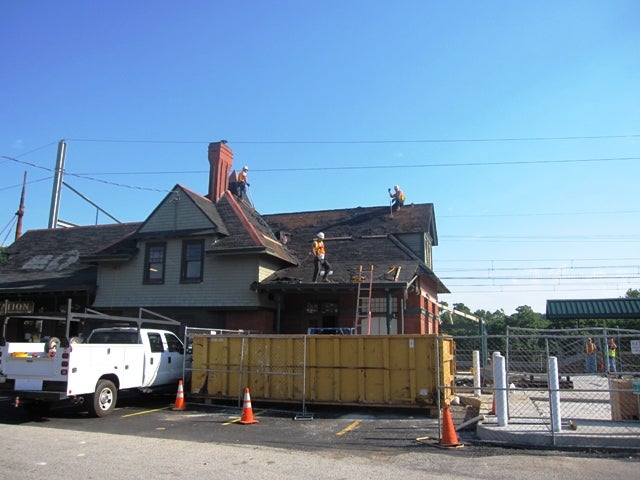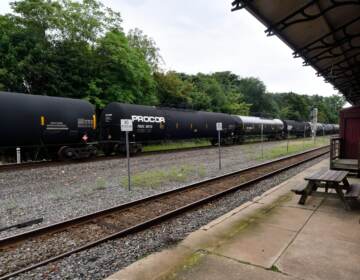How SEPTA is spreading stimulus dollars

Wayne Station renovation
June 25
By Anthony Campisi
For PlanPhilly
WASHINGTON — In an occasionally testy hearing ostensibly about the federal stimulus package, SEPTA general manager Joseph M. Casey and top transportation officials walked a congressional committee through their efforts to spend stimulus money on Thursday.
Casey and other state and federal officials testified before a hearing of the House Transportation and Infrastructure Committee held 120 days after President Obama signed the American Recovery and Reinvestment Act into law — which provided $48.1 billion in transportation funding.
Though the congressmen lauded the transportation agencies for the speed with which they have allocated their allotments, they devoted most of the hearing to blasting the administration’s transportation-funding plan and pushing their own six-year funding bill. “We’ve had no outreach from the administration … and I’m personally offended by that,” committee chairman James L. Oberstar (D-Minn.) complained to federal transportation officials. Casey, speaking on behalf of the American Public Transportation Association, a trade group, said that 58 percent of the stimulus funds allocated to mass transit agencies had already been designated for specific projects.
SEPTA has allocated 70 percent of its $191 million share, spreading it across 32 projects. He also lauded a bill that Obama signed Wednesday that would allow cash-strapped transit authorities to devote up to 10 percent of their stimulus allocation to their operating budgets. Though SEPTA isn’t in need of the extra funding, he said it would allow other transit agencies to balance their budgets without cutting service and laying off workers.
At the same time, Casey called on the committee to continue its push for a six-year transportation bill, echoing comments made my other transportation officials and committee members. To illustrate his point, he used the agency’s own aging infrastructure as an example: About half of SEPTA’s 150 stations need either extensive repairs or replacement; 16 of its 19 power substations are over 75 years old; and 100 of SEPTA’s 400 bridges are over 100 years old.
A survey conducted by APTA found that transit agencies had a total of 787 projects, representing $16 billion in spending, were shovel ready. The stimulus package only began to chip away at the maintenance backlog, he said.
The country’s seven largest rail systems need $50 billion in maintenance overhauls to bring them into a state of good repair, Casey said. Of that, SEPTA needs $4 billion. As for Amtrak, $1.1 billion of the $1.3 billion set aside for it by the Federal Railroad Administration has been allocated.
Amtrak president Joseph H. Boardman pointed to coming construction of new railcars in the system’s Delaware rail yard and $21 million devoted to the renovation of the Wilmington train station as good examples of the expenditures. The committee had voted on a transit reauthorization bill earlier in the week, and members spent most of the hearing criticizing the administration’s own infrastructure plan, which would extend the Bush-era transportation funding law another 18 months.
Oberstar warned that Obama’s plan would, in effect, strike a double blow to economic growth in the middle of the worst recession since the Great Depression. While he argued that his committee’s bill, which passed with bipartisan support and is awaiting a funding component, would add 6 million new jobs over the course of its lifespan, he said that the Obama’s plan would deplete the highway trust fund — which funds most transportation projects — to its lowest level ever, thereby endangering future infrastructure investment. This would happen, he argued, at precisely the time when stimulus funds would be drying up.
Committee members and administration officials did agree that replenishing the highway trust funs the most pressing matter facing the federal infrastructure projects — if nothing is done, it will be unable to meet its financial obligations by the end of August.
Officials fired back that Obama’s budget proposal calls for an “uptick” in overall transit funding, paid for in part by increasing the transportation appropriation from the general fund. The focus should be on replenishing the trust fund, not in pushing for a six-year plan the country can’t afford in the middle of a recession, said Jeffrey F. Paniati, acting administrator of the Federal Highway Administration.
But regional transit officials and business leaders supported the committee’s efforts to pass a six-year plan, saying that it would enable more effective long-term transportation planning and allow states to focus on long-term projects, as well as chip away at their maintenance backlog.
“A long-term bill will inject stability in the overall marketplace,” said John Keating, president and CEO of construction company Oldcastle Materials Group East, who was representing the American Road and Transportation Builders Association.
Contact the reporter at campisi.Anthony@gmail.com
WHYY is your source for fact-based, in-depth journalism and information. As a nonprofit organization, we rely on financial support from readers like you. Please give today.






